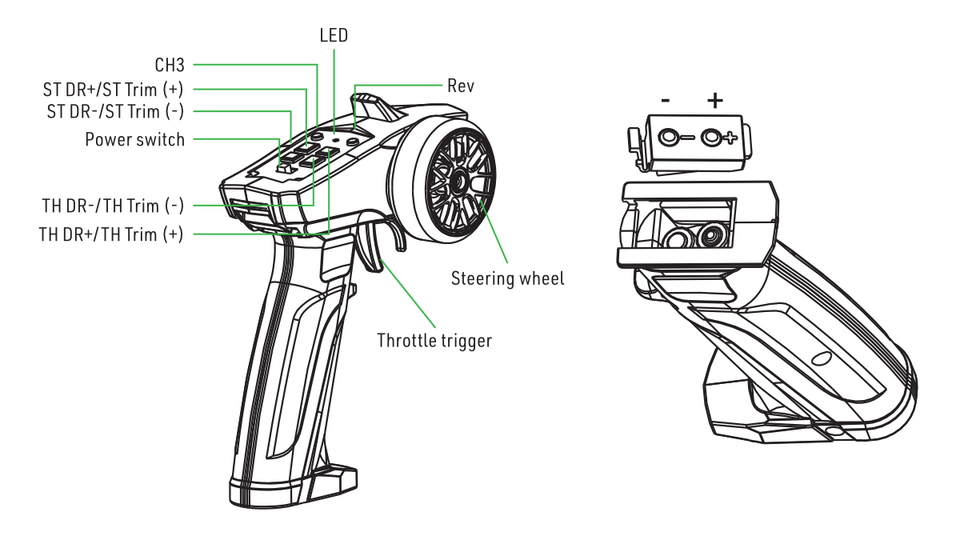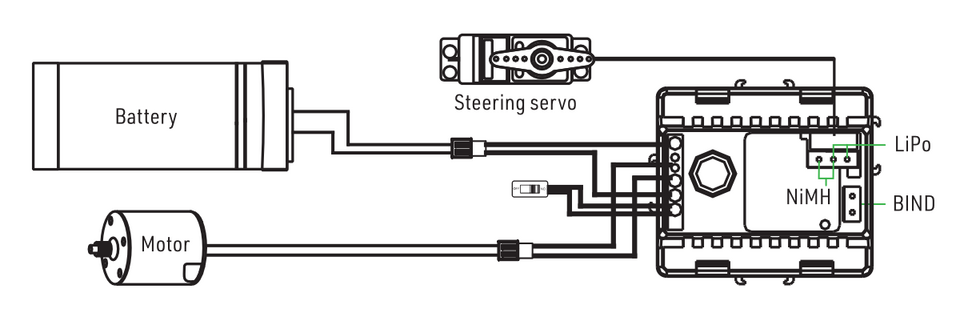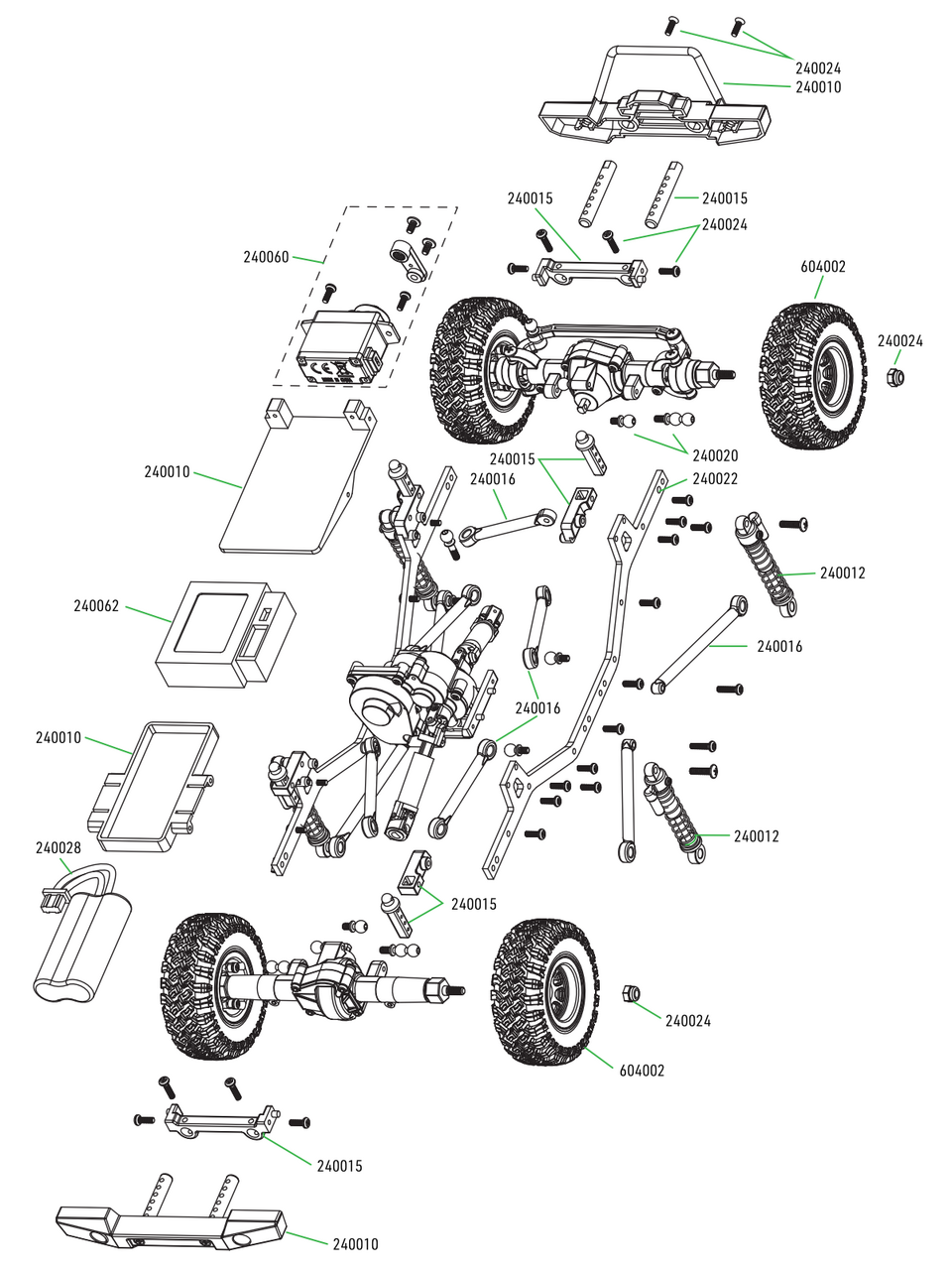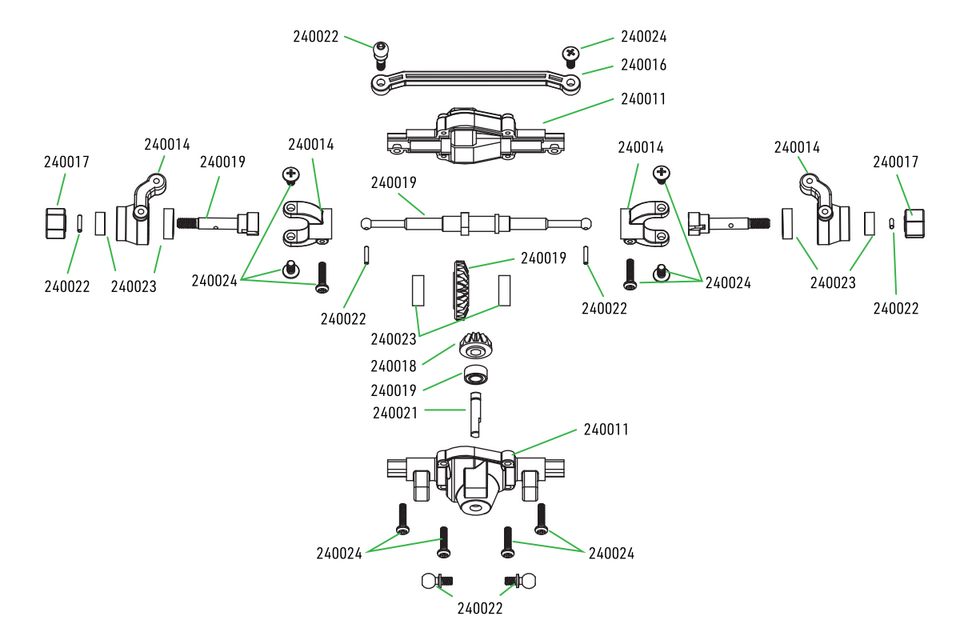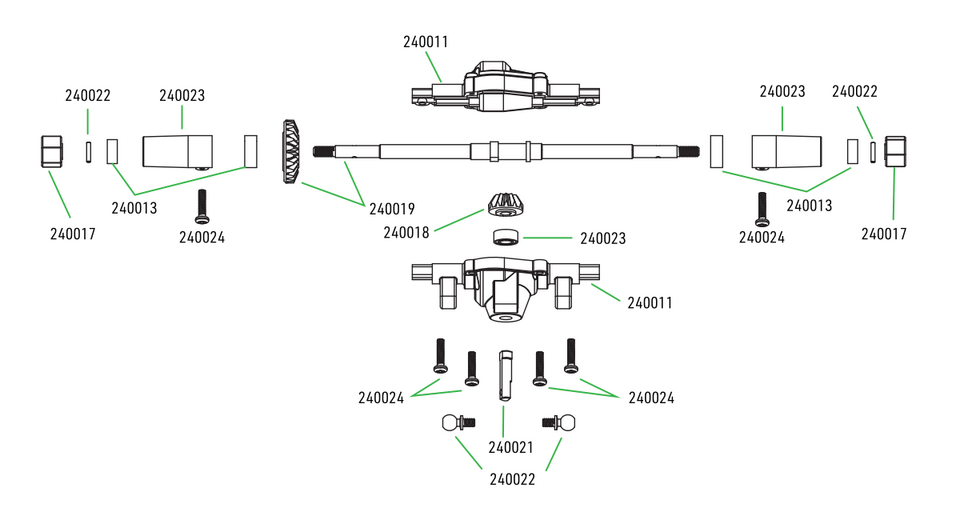KAVAN GRE-24 - Návod k použití
Úvod
Děkujeme Vám za zakoupení rock crawleru KAVAN řady GRE-24, jednoho z nejrealističtějších, nejvýkonnějších a nejspolehlivějších trucků ve své kategorii. S auty řady KAVAN 1:24 můžete do terénu vyrazit rovnou z krabice!
Upozornění
- Toto není hračka! Model je určen pro samostatné provozování osobami staršími 15 let.
- Pokud nebudete toto vozidlo provozovat a udržovat bezpečným způsobem, může to vést ke zranění osob.
- Poškozené části nahrazujte výhradně originálními náhradními díly. Věnujte pozornost dodržení správné polarity všech vodičů v autě.
- Používejte pouze odpovídající jednočlánkové (1S, 3,7 V) lithiumpolymerové akumulátory. Akumulátory nepřebíjejte ani nadměrně nevybíjejte, protože to by mohlo vést k jejich poškození s rizikem požáru. Pokud se akumulátor během nabíjení silně zahřeje, nabíjení ihned přerušte a akumulátor odpojte od nabíječe. Akumulátor při nabíjení nikdy nenechávejte bez dozoru. Pokud si nejste jistí, jak nabíjet akumulátor dodávaný s modelem, poraďte se zkušenými modeláři. Nedovolte dětem akumulátor nabíjet bez dohledu dospělého.
- Motor se za provozu zahřívá. Mezi jízdami nechejte model 10-15 minut vychladnout. Díky tomu prodloužíte životnost vašeho auta.
- Při výběru prostoru pro ježdění se řiďte zdravým rozumem. Nejezděte po ulicích, parkovištích apod. - kdekoliv byste se mohli střetnout se skutečným autem, osobami nebo zvířaty. Nejezděte v blízkosti elektrických vedení, vysílačů a převaděčů, hluboké vody nebo v nestabilním terénu. Řidič auta nese výhradní odpovědnost za svoje počínání.
- Tento výrobek je sestaven z jemných elektronických částí. Je kriticky důležité jej chránit před vlhkostí a jiným znečištěním. Byl-li vystaven vlhkému prostředí, ujistěte se, že jeho elektronika zcela vyschla dříve, než s ním znovu vyjedete.
- Než s autem vyjedete na trať, vždy zkontrolujte dosah RC soupravy, abyste předešli poškození modelu v důsledku ztráty spojení nebo rušení.
- Při provozu berte ohled na vaše schopnosti. Je-li model nebezpečné vyzvednout z určitého místa, nikdy to za to riziko nestojí.
- Vždy nejprve zapněte vysílač a až teprve poté připojujte pohonný akumulátor v autě. Po jízdě vždy nejprve vypněte vypínač přijímače, potom vždy odpojte pohonný akumulátor - teprve až nakonec vypněte vysílač. Pokud byste postupovali opačně, model se může vymknout vaší kontrole a způsobit vážné škody.
- Nikdy nedovolte, aby se akumulátory/baterie ve vysílači vybily tak, že ztratíte kontrolu nad modelem.
- Plasty, z nichž je model vyroben, jsou hořlavé a náchylné k poškození nebo deformaci v důsledku vysoké nebo nízké teploty. Model neskladujte v blízkosti zdrojů tepla, jako jsou trouby nebo topná tělesa. Skladujte jej v suché místnosti při pokojové teplotě.
- Nikdy nezkracujte přijímačovou anténu; mohlo by to snížit dosah vaší RC soupravy.
Nabíjení pohonného akumulátoru
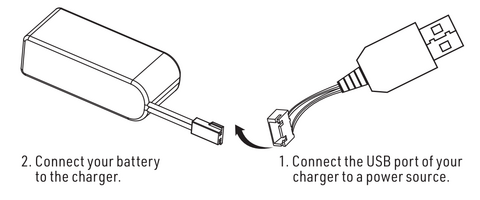
Než začnete, připravte si čtyři čerstvé AAA alkalické baterie nebo NiMH akumulátory pro vysílač (nejsou dodávány s modelem) a nabijte pohonný LiPo akumulátor dodávaný s modelem.
- Nabíječ zapojte do USB portu a potom k němu připojte pohonný akumulátor.
- Během nabíjení indikační LED na nabíječi svítí červeně. Po dokončení nabíjení zhasne.
- Akumulátor neponechávejte při nabíjení bez dozoru.
- Pokud je nabíječ nebo akumulátor horký, akumulátor a nabíječ ihned odpojte, protože by to mohlo být způsobeno vnitřním zkratem.
Lithium Polymer Battery Warning
- Never charge a lithium polymer battery with a charger designed for NiCd, NIMH, or any other type of battery than LiPo. Use ONLY a charger designed for LiPo batteries.
- Do not leave the LiPo battery unattended during charging.
- Do not overcharge the battery.
- Always charge LiPo batteries placed on non-flammable, heat-resistant surfaces.
- Use of a LiPo-safe bag or container while charging is strongly recommended. Do not allow LiPo cells to overheat at any time. Cells which reach greater than 60 °C will usually become damaged and will catch fire.
- Do not charge the LiPo pack while it is still in the model. Never charge or store battery packs in a vehicle.
- Do not over-discharge LiPo; doing so will damage the battery.
- Do not expose LiPo cells to water or moisture at any time.
- Do not store battery near open flame or heater.
- Do not assemble LiPo cells or pre-assembled packs together with other LiPo cells or packs.
- Always store LiPo batteries in a secure location away from children.
- Always remove the LiPo battery if the model is involved in any kind of crash.
- Carefully inspect the battery and connectors for even the smallest damage.
- Do not allow the electrolyte to get into the eyes or on the skin. Wash affected areas immediately if they come into contact with electrolytes. Do not alter or modify the connectors or wires of a LiPo battery pack.
- Always inspect the condition of the battery before charging and operating.
- Do not short-circuit the LiPo battery.
- Avoid direct contact with a leaky/damaged battery.
- Do not charge the battery out of the recommended temperature range (0–45 °C).
Transmitter controls
Install the transmitter batteries
- Remove the battery compartment cover.
- Replace the used batteries with new AAA-size batteries.
Specification
Transmitter
- Input Voltage: 4× 1.2/1.5 V AAA
- Modulation: FHSS
- Frequency Range: 2.405–2.478 GHz
- Output Power: <20dBm
Receiver
- Input Voltage: 3.7 V (1S LiPo)
- Modulation: FHSS
- Frequency Range: 2.405–2.478 GHz
- Output Power: -
Transmitter and receiver binding
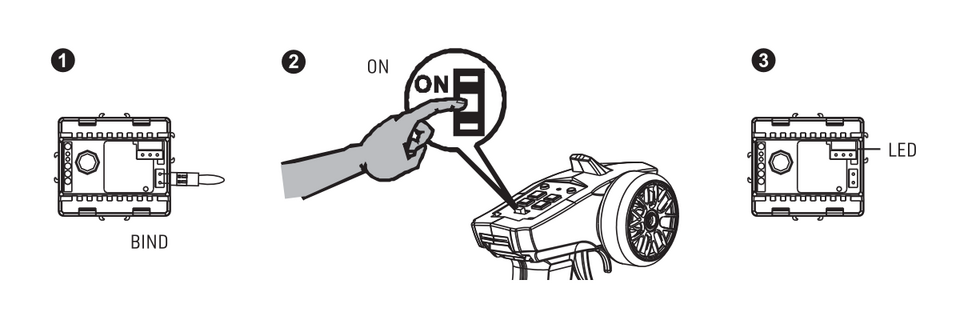
- Connect the receiver to the battery. Place the bind plug into the port labelled "BIND". Turn on the receiver switch. The LED will flash very shortly, go off and then blink again. Immediately before it goes on again, remove the binding plug. The LED will start blinking rapidly.
- Turn on the transmitter.
- The LED on the receiver should now turn on and remain solid, indicating that the binding process is complete.
Transmitter function
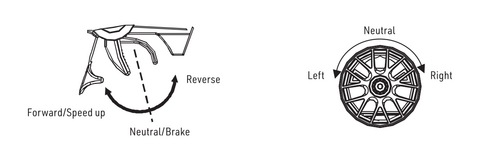
- Push the trigger forward to slow down or brake.
- Pull the trigger backward to accelerate.
Throttle trim: If the vehicle inches forward or backwards without throttle input, adjust the trim to set the neutral throttle position.
Steering trim: If the vehicle veers left or right without any steering input, use the steering trim to adjust the steering servo until the vehicle tracks straight.
Operating procedure
- Always turn the transmitter on before turning on the vehicle.
- Always switch off the vehicle and disconnect the battery BEFORE turning off the transmitter.
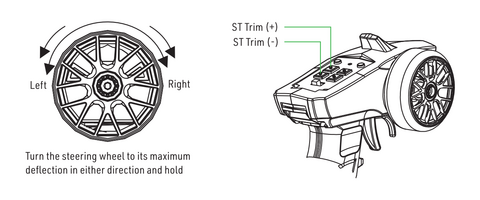
Channel reverse
- Steering: if your car turns right whilst turning the steering wheel left (or vice versa) - turn the steering wheel to its maximum deflection in either direction and hold; simultaneously press and hold the steering REV button and the steering channel will be reversed.
- Throttle: if your car runs back whilst pulling the throttle trigger - with the car inverted (wheels not touching the ground), press the throttle trigger down to its maximum position and hold; simultaneously press and hold the throttle REV button and the throttle channel will be reversed.
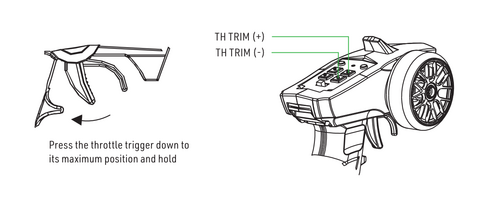
Control rate
- Steering: turn the steering wheel to its maximum deflection in either direction and hold; press the ST trim + or - buttons to increase or decrease the steering rate. If the steering is unresponsive, keep pressing the steering trim+ button while holding the steering wheel at maximum deflection.
- Throttle: with the car inverted (Wheels not touching the ground), press the throttle trigger down to its maximum position and hold; press the TH trim + or - buttons to increase or decrease the throttle rate. If the throttle is unresponsive, keep pressing the throttle trim + button while holding the throttle trigger down at its maximum point.
Maintenance
Proper maintenance is very important. Make sure to always perform appropriate maintenance after driving so that you can enjoy driving without problems next time.
- Completely remove all dirt and debris from the vehicle, especially in the suspension, drive shafts and steering parts.
- Inspect each part and screw for loosening, missing parts or damages.
- You should always make sure your wheels are tight and parts move freely after and before use. Apply fine grease for plastic gears wherever needed.
- Do not use aggressive chemicals or solvents for cleaning, otherwise the electronics and plastic parts might be damaged. Use compressed air for cleaning, a soft paintbrush or toothbrush.
Exploded views
Recycling and waste disposal note (European Union)

Electrical equipment marked with the crossed-out waste bin symbol must not be discarded in the domestic waste; it should be disposed of via the appropriate specialised disposal system. In the countries of the EU (European Union) electrical devices must not be discarded via the normal domestic waste system (WEEE - Waste of Electrical and Electronic Equipment, Directive 2012/19/EU). You can take your unwanted equipment to your nearest public collection point or recycling centre, where it will be disposed of in the proper manner at no charge to you. By disposing of your old equipment in a responsible manner you make an important contribution to the safeguarding of the environment.
EU declaration of conformity (European Union)

Hereby, KAVAN Europe s.r.o. declares that the equipment KAVAN GRE-24 model car with an RC kit are in compliance with the essential requirements as laid down in the EU directive(s) concerning electromagnetic compatibility. The full text of the EU Declaration of Conformity is available at www.kavanrc.com/doc.
Guarantee
The KAVAN Europe s.r.o. products are covered by a guarantee that fulfils the currently valid legal requirements in your country. If you wish to make a claim under guarantee, please contact the retailer from whom you first purchased the equipment. The guarantee does not cover faults which were caused in the following ways: crashes, improper use, incorrect connection, reversed polarity, maintenance work carried out late, incorrectly or not at all, or by unauthorised personnel, use of other than genuine KAVAN Europe s.r.o. accessories, modifications or repairs which were not carried out by KAVAN Europe s.r.o. or an authorised KAVAN Europe s.r.o., accidental or deliberate damage, defects caused by normal wear and tear, operation outside the Specification, or in conjunction with equipment made by other manufacturers. Please be sure to read the appropriate information sheets in the product documentation.


